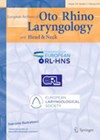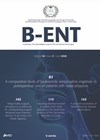
Journal Reviews
Systematic review and meta-analysis showing benefit of cochlear implantation in adults with single-sided deafness
This article presents results of a systematic review and meta-analysis to further investigate the impact of unilateral cochlear implantation (CI) in adults with single-sided deafness (SSD) with regards to speech perception in quiet and noise, tinnitus, sound localisation and quality...
Cochlear implantation in enlarged vestibular aqueduct patients
In this systematic review, the authors describe the complications and outcomes of cochlear implantation in patients with enlarged vestibular aqueduct (EVA). The authors reviewed five major databases and included 4035 patients from 34 studies. Of these, 853 patients (21.14%) had...
Age and sleep disorders as risk factors for Ménière’s disease
Decades after it was first described, the pathophysiology of Ménière’s disease is still a subject for research and discussion, with several controversies regarding its management. Several factors have been reported to cause Ménière’s disease including viral infections, allergies, genetic factors,...
An understandable backup
This small study comparing the auditory temporal processing of seven younger adults with that of seven older adults does not show anything breathtakingly new in its conclusions. After the assessment to rule out compounding factors such as middle ear pathology,...
Third-party disability in cochlear implantation
The authors of this study note significant third-party disability experienced by significant others (SO) or communication partners of persons with hearing impairment (PHI). The study explored contextual and psychosocial factors for successful auditory rehabilitation, advocating for the importance of including...
Blood-sampling prognostic predictors for Bell’s palsy
Bell’s palsy is generally defined as an acute-onset unilateral idiopathic mononeuropathy in the facial nerve. It is of unknown aetiology, however, inflammation is considered a major cause. Electroneurography assessing nerve excitability is the most reliable examination for predicting prognosis of...
Measurement of HINTS in peripheral vestibulopathy
Dizziness; Head impulse test; Nystagmus; Skew deviation; Vertigo.
Balloon eustachian tuboplasty and inferior turbinectomy
This Taiwanese prospective case-control study looked at concurrent inferior turbinectomy (via submucosal turbinectomy) and balloon eustachian tuboplasty on symptoms related to eustachian tube dysfunction. A total of 50 patients who underwent inferior turbinectomy with balloon eustachian tuboplasty were recruited prospectively...
Endolymphatic sac tumours
The authors performed a systematic review of literature and describe the clinical signs and symptoms of endolymphatic sac tumours (ELST) in this article. A total of 113 patients and 118 cases from 26 studies were included in the study. The...
Small but significant
These authors try to circumnavigate the conundrum of what is influenced by what. For something so small, the impact of the Stria Vascularis cannot be understated. The difficulty in reviewing the influence of loop diuretics or aminoglycosides on the Stria...
Temporal bone drilling using artificial versus cadaveric specimens - does the specimen precipitate altered drilling techniques?
Hochman et al set an ambitious goal in their study analysing drilling strokes of eight otolaryngology residents (junior: PGY 1-3; senior: PGY 4-5) during temporal bone (TB) drilling practice using cadaveric and artificial specimens. Each trainee dissected one cadaveric and...
Impact of vestibular rehabilitation on patients with peripheral vestibular disorders
Vestibular rehabilitation is a widely used treatment for vestibular dysfunction. It can improve dizziness, fall risk, balance, and emotional status. However, some patients do not get benefit from vestibular rehabilitation. In this study, the authors assessed the impact of dizziness...















